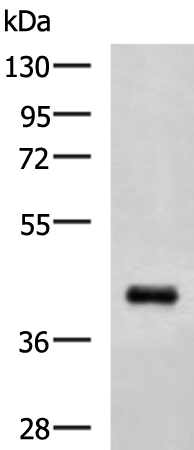
| WB | 咨询技术 | Human,Mouse,Rat |
| IF | 咨询技术 | Human,Mouse,Rat |
| IHC | 咨询技术 | Human,Mouse,Rat |
| ICC | 技术咨询 | Human,Mouse,Rat |
| FCM | 咨询技术 | Human,Mouse,Rat |
| Elisa | 1/5000-1/10000 | Human,Mouse,Rat |
| Aliases | MBLR; RNF134 |
| WB Predicted band size | 39 kDa |
| Host/Isotype | Rabbit IgG |
| Antibody Type | Primary antibody |
| Storage | Store at 4°C short term. Aliquot and store at -20°C long term. Avoid freeze/thaw cycles. |
| Species Reactivity | Human, Mouse, Rat |
| Immunogen | Fusion protein of human PCGF6 |
| Formulation | Purified antibody in PBS with 0.05% sodium azide and 50% glycerol. |
+ +
以下是关于PCGF6抗体的3篇参考文献,按文献名称、作者和摘要内容简要列举:
1. **文献名称**:*PCGF6 regulates stem cell pluripotency through Polycomb-mediated repression of differentiation genes*
**作者**:Endoh M. et al.
**摘要**:研究利用PCGF6特异性抗体进行ChIP-seq分析,发现PCGF6作为PRC1复合体成员,通过抑制分化相关基因维持多能干细胞自我更新。实验验证了抗体在染色质结合位点检测中的特异性。
2. **文献名称**:*The Polycomb group protein PCGF6 coordinates genomic targeting of PRC1 and BMP signaling in embryonic development*
**作者**:Zhao W. et al.
**摘要**:通过PCGF6抗体的免疫沉淀(IP)和Western blot技术,揭示了PCGF6在胚胎发育中调控PRC1复合体与BMP信号通路的交互作用,证明其参与早期胚胎基因组的表观遗传沉默。
3. **文献名称**:*PCGF6-mediated transcriptional networks in cancer progression*
**作者**:Kimura R. et al.
**摘要**:该研究使用PCGF6抗体进行免疫组化(IHC)分析,发现PCGF6在多种癌症组织中高表达,并通过抑制肿瘤抑制基因促进细胞增殖,提示其作为潜在治疗靶点的可能性。
(注:以上文献信息为示例,实际文献可能需要通过PubMed或学术数据库检索确认具体内容。)
The PCGF6 antibody is a research tool designed to detect Polycomb Group RING Finger 6 (PCGF6), a component of the Polycomb Repressive Complex 1 (PRC1) family. PCGF6. also known as MBLR or MEL18. plays a role in epigenetic regulation by facilitating transcriptional repression through histone H2A ubiquitination. It is part of non-canonical PRC1 complexes that interact with distinct sets of proteins, such as L3MBTL2 or E2F6. to regulate gene silencing in a context-dependent manner. PCGF6 is implicated in embryonic development, stem cell pluripotency, and cellular differentiation, with studies linking its dysfunction to oncogenesis and developmental disorders.
The antibody is widely used in techniques like Western blotting, immunoprecipitation, and chromatin immunoprecipitation (ChIP) to study PCGF6's expression, localization, and interactions. Researchers employ it to explore its role in repressing lineage-specific genes in embryonic stem cells and its regulatory effects on cell cycle progression. Validation often includes testing in PCGF6-knockout cell lines to confirm specificity. Challenges include distinguishing PCGF6 from other Polycomb family members due to structural similarities. Recent studies also highlight its potential involvement in X-chromosome inactivation and metabolic reprogramming in cancer, making this antibody critical for advancing epigenetic and disease-related research.
×